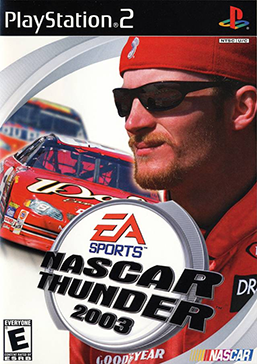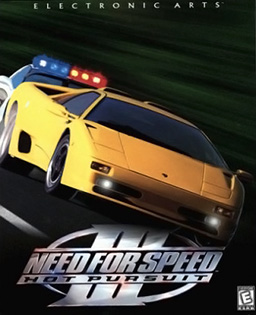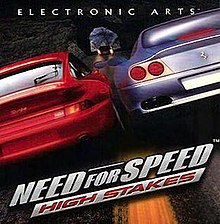Need for Speed (NFS) is a racing game franchise published by Electronic Arts and currently developed by Criterion Games, the developers of Burnout. The series generally centers around illegal street racing and tasks players to complete various types of races while evading the local law enforcement in police pursuits. The series is one of EA's oldest franchises not published under their EA Sports brand. The series released its first title, The Need for Speed, in 1994. The most recent game, Need for Speed Unbound, was released on December 2, 2022. Additionally, a free-to-play mobile installment released in 2015, Need for Speed: No Limits, is actively developed by Firemonkeys Studios, the developers of Real Racing 3.

Midtown Madness is a 1999 racing game developed by Angel Studios and published by Microsoft for Microsoft Windows. The demo version was released in April 1999. Two sequels followed, with Midtown Madness 2 released in September 2000 and Midtown Madness 3 released in June 2003 for the Xbox. The game is set in Chicago; the object is for the player to win street races and obtain new cars.

Need for Speed: Underground is a 2003 racing video game and the seventh installment in the Need for Speed series. It was developed by EA Black Box and published by Electronic Arts. Three different versions of the game were produced: one for consoles and Microsoft Windows, and another for the Game Boy Advance. An arcade version was additionally developed by Global VR, and was published by Konami with assistance from Electronic Arts.

Need for Speed: Hot Pursuit 2 is a 2002 racing video game, the sixth installment in the Need for Speed series and the sequel to 1998's Need for Speed III: Hot Pursuit. It was developed by EA Black Box for the PlayStation 2, and by EA Seattle for GameCube, Xbox, and Microsoft Windows. It features cars from various high-performance and exotic car manufacturers. Players can compete in races using these cars, or opt to play as a police officer and pursue speeders.

Need for Speed: Underground 2 is a 2004 racing video game developed by EA Black Box and published by Electronic Arts. It is the eighth installment in the Need for Speed series and the direct sequel to Need for Speed: Underground. It was developed for Microsoft Windows, GameCube, PlayStation 2, and Xbox. Game Boy Advance and Nintendo DS versions were developed by Pocketeers, and a PlayStation Portable version, titled Need for Speed: Underground Rivals, was developed by Team Fusion. Another version for mobile phones was also developed. Like its predecessor, it was also commercially successful, selling around 11 million copies worldwide and breaking sales records in the United Kingdom.

Star Wars Episode I: Racer is a 1999 racing video game based on the podracing sequence in the film Star Wars: Episode I – The Phantom Menace. The game features all of the racers and race course on Tatooine from The Phantom Menace. It adds several new courses, on Tatooine and various planets. It has several single player modes, including a tournament mode. The format of multiplayer mode varies by platform. Jake Lloyd and Lewis MacLeod, who portrayed Anakin Skywalker and Sebulba in The Phantom Menace, reprise their film roles in the game.

Need for Speed II is a 1997 racing video game released for PlayStation and Microsoft Windows. It is a part of the Need for Speed series and is the second installment, following The Need for Speed.

Need for Speed: Porsche Unleashed, released as Need for Speed: Porsche 2000 in Europe and Need for Speed: Porsche in Latin America and Germany, is a 2000 racing video game. It is the fifth installment in the Need for Speed series. Unlike other NFS titles, Porsche Unleashed centers on racing Porsche sports cars, with models ranging from years 1950 to 2000.

NASCAR Thunder 2003 is the sixth edition of the EA Sports' NASCAR racing simulator series. Developed by EA Tiburon and Budcat Creations and published by EA Sports. It was released for PlayStation, PlayStation 2, GameCube, and Xbox on September 19, 2002, and for Microsoft Windows on October 16. The product features Dale Earnhardt Jr. on the cover. It was the first time the NASCAR's Most Popular Driver Award recipient was featured on the cover, although he did not win the award for the first time until the following year. Dale Earnhardt appeared in the game as a driver as a result of entering his name as a Create-A-Car driver's name; he did not appear in the previous game due to his death. He appeared as a legend in subsequent games.

Sports Car GT is a 1999 racing sim game based on GT racing. It was published by Electronic Arts (EA) and developed by Image Space Incorporated for Microsoft Windows, and Point of View for PlayStation. Both editions of the game feature co-development by Westwood Studios. The PC version received "favorable" reviews, while the PlayStation version received "mixed" reviews.

Lego Racers is a Lego-themed racing video game developed by High Voltage Software and published by Lego Media in 1999.

Need for Speed III: Hot Pursuit is a 1998 racing video game developed for PlayStation by EA Canada and Microsoft Windows by EA Seattle, and published by Electronic Arts. It is the third major installment in the Need for Speed franchise, incorporating police pursuits as a major part of gameplay. Hot Pursuit remains focused on racing using exotic sports cars, but features races that primarily take place in locations within North America, including varied settings and climates. Police AI is improved over the first game, utilizing several tactics to stop both the player and opponent. The PlayStation version was released on March 25, 1998, while the Windows version was released on October 12 the same year. The game received critical success, with praise for its graphics and customization options. It received a direct sequel in 2002 and a reboot in 2010.

Need for Speed: Carbon is a 2006 racing video game and the tenth installment in the Need for Speed series. Developed by EA Black Box, Rovio Mobile and published by Electronic Arts, it was released on October 31, 2006, for the PlayStation 2, PlayStation 3, Xbox, Xbox 360, GameCube, Windows, and Mac OS X, and on November 19, 2006 as a launch title for the Wii and in 2008 for arcade cabinets. The game sees players conducting illegal street races within the fictional city of Palmont City, with the game's main story taking place after the events of Need for Speed: Most Wanted and focusing on the player's character taking control of the city from various street-racing gangs. While the gameplay is similar to its predecessor, Carbon introduced a number of new features, including crews and racing wingmen, Touge-styled racing events, and greater customization options.

Test Drive 4 is a racing game developed by Pitbull Syndicate and published by Accolade for PlayStation and Microsoft Windows in 1997. It offers 14 supercars and muscle cars, and tasks the player with beating computer opponents in tracks set in real life locales. The game's tracks are long courses with rural roads and urban streets, and commonly feature traffic and short corners. The player has to arrive at each checkpoint before the Checkpoint Timer expires, resulting in additional time, and crossing the finish line is required to complete the race. Test Drive 4's commercial success briefly made Test Drive the best selling racing franchise, but the game received mixed reviews. In 1999 the game was republished under the Greatest Hits label after selling 850,000 copies within one year of its release.

Test Drive 6 is a racing video game developed by Pitbull Syndicate for PlayStation, Microsoft Windows and Dreamcast. In the United States the game was published by Infogrames North America, while in Europe the game was published by Cryo Interactive. The game featured 37 licensed cars, plus four police car variants. As a first for the series, cars from General Motors are not playable in this game, instead they appear as traffic cars. The soundtrack featured industrial rock and techno music from artists such as Fear Factory, Lunatic Calm and Cirrus.

Need for Speed: ProStreet is a 2007 racing video game developed by EA Black Box and published by Electronic Arts. It is the eleventh installment in the Need for Speed series and a follow-up to Need for Speed: Carbon. Unlike its immediate predecessors, which focused on the contemporary illegal street racing scene, ProStreet focuses on legal circuit races that take place on closed tracks. The game blends elements of both sim and arcade racing games, requiring players to customize and tune cars for various race modes. Most races take place in real-world locations such as the Portland International Raceway, Mondello Park, and Autopolis.

Need for Speed: Hot Pursuit is a 2010 racing video game developed by Criterion Games and published by Electronic Arts for PlayStation 3, Xbox 360, Wii, Microsoft Windows, iOS, Android, webOS, and Windows Phone. The Wii version was developed by Exient Entertainment. Hot Pursuit is the sixteenth Need for Speed title and was released in November 2010, with digital distribution versions released within December 2010. This version is a reboot of Need for Speed III: Hot Pursuit (1998). A remastered version, titled Need for Speed: Hot Pursuit Remastered, was released on November 6, 2020, for Microsoft Windows, PlayStation 4 and Xbox One, and on November 13, 2020, for Nintendo Switch.

Need for Speed: Most Wanted is a 2012 racing game developed by Criterion Games and published by Electronic Arts. Most Wanted is the nineteenth title in the Need for Speed series and was released worldwide for Microsoft Windows, PlayStation 3, Xbox 360, PlayStation Vita, iOS and Android, beginning in North America in 2012, with a Wii U version following in 2013 under the title Need for Speed: Most Wanted U. The game picked up on the Most Wanted intellectual property, as opposed to the Hot Pursuit reboot that Criterion Games developed previously.

Need for Speed: Most Wanted is a 2005 racing video game, and the ninth installment in the Need for Speed series. Developed by EA Canada and EA Black Box and published by Electronic Arts, it was released in November 2005 for PlayStation 2, Xbox, GameCube, Nintendo DS, Microsoft Windows, Game Boy Advance and Xbox 360. An additional version, Need for Speed: Most Wanted 5-1-0, was released in the same year for PlayStation Portable. The game focuses on street racing-oriented gameplay involving a selection of events and racing circuits found within the fictional city of Rockport, with the game's main story involving players taking on the role of a street racer who must compete against 15 of the city's most elite street racers to become the most wanted racer of the group, in the process seeking revenge against one of the groups who took their car and developing a feud with the city's police department.

Hot Wheels Micro Racers is a racing video game developed by Unique Development Studios (UDS) and published by Mattel Interactive for Microsoft Windows. The game is based on the Hot Wheels toyline, and was unveiled at the American International Toy Fair in February 2000, as a competitor to Micro Machines. Hot Wheels Micro Racers was released on April 28, 2000, and came packaged with a free Hot Wheels car and poster.



















